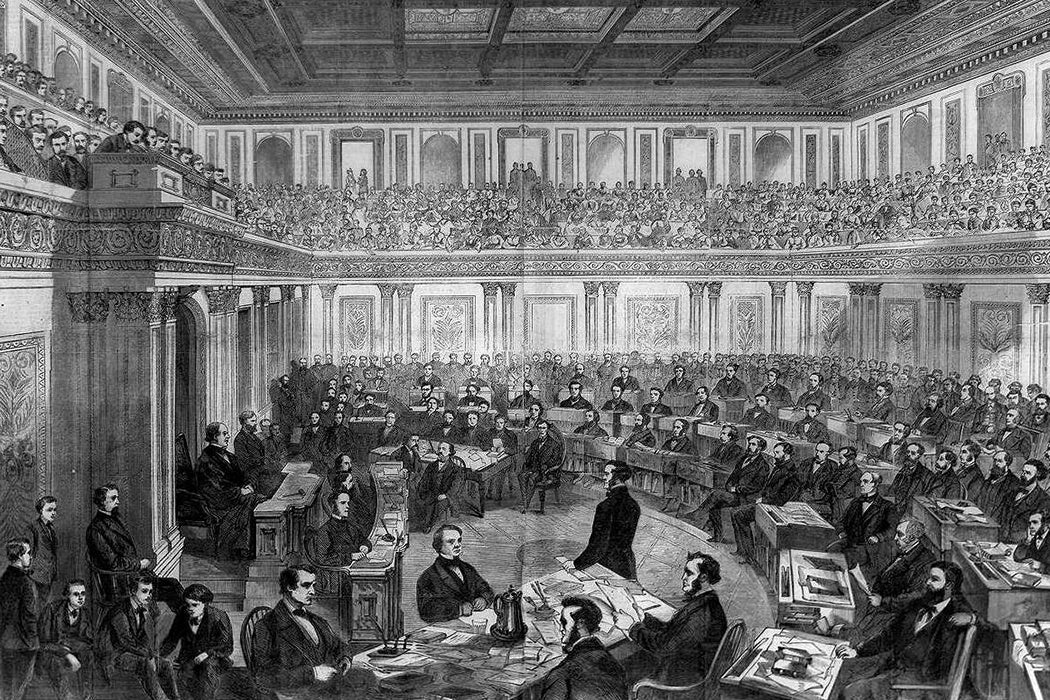Impeachment is something much talked about but rarely done. While the U.S. House of Representatives has the “sole Power of Impeachment,” according to the Constitution, it is the U.S. Senate that has the “sole Power to try all Impeachments.” There have been a total of 19 impeachment trials in the Senate: eight convictions, seven acquittals, three dismissals, and one resignation with no further action.
The Senate determines how such trials proceed, with, for instance, the full Senate or a more court-like committee. In Nixon v. U.S. (1993), the Supreme Court said the Senate can make its own rules in this matter. (Note that that case referred to former judge Walter Nixon, Jr., not the unrelated President Richard M. Nixon, who resigned before the House could impeach him in 1974.)
Most of these impeachment trials have been of federal judges, but the ones everybody remembers are the two Presidential impeachments: Andrew Johnson in 1868 and Bill Clinton in 1999. Both were acquitted. A single senator has been impeached: William Blount of Tennessee, who had his charges dismissed even as he was expelled from the Senate. That was in 1799.
Punishment for impeachment is removal from office, and sometimes the disqualification from holding office again. According to the Constitution, federal officials can be impeached for “Treason, Bribery, or other high Crimes and Misdemeanors.” But what exactly constitutes “high crimes and misdemeanors” has been the subject of debate since… oh, roughly 1386, when the phrase was first used in English.
Legal scholar Jonathan Turley dives deep into this history. Noting that social and political turmoil tended to foster calls for impeachments throughout the Anglo-American tradition, he defines the process as “a method of resolving factional disputes over executive or judicial legitimacy.”
Like so much of our constitutional history, impeachment came out of the long English experience of reducing the power of monarchy. In that English tradition, “divers deceits” was once the standard for determining guilt, as were “treasons, felonies, and mischiefs.” As Turley notes, the process was one in which Parliament tried to “exercise control over Crown officials in the absence of alternative constitutional means.” There were few other tools to take on all the King’s men.
This jumble crossed the Atlantic. Frustration with the colonial system led to impeachment being used as a check on executive authority. The first official to be impeached in the colonies was Virginia’s colonial governor, in 1635. The process was “an overt political challenge to British rule and a reaffirmation of republican values.” The colonials would only go so far under London’s leash before they acted against London’s agents, using the time-tested methods they inherited from the motherland.
But then it came time to codify the American Constitution. Turley calls the Senate Impeachment Clause (Article 1, Sec. 3) “one of most clear and concrete provisions” in the Constitution, instructions that have not been subject to much debate over the centuries, unlike much else in the document. Ultimately, he sees the Senate trial process as “vitally important to the integrity of the system, as it has often changed the views of both senators and the public regarding the basis of the impeachment allegations.”
Once a Week
Considering the well-documented history of corruption in high places over more than two centuries, it remains a little surprising that impeachment has been so sparingly used. But then, as Turley argues, it has always been more about politics than crimes.







